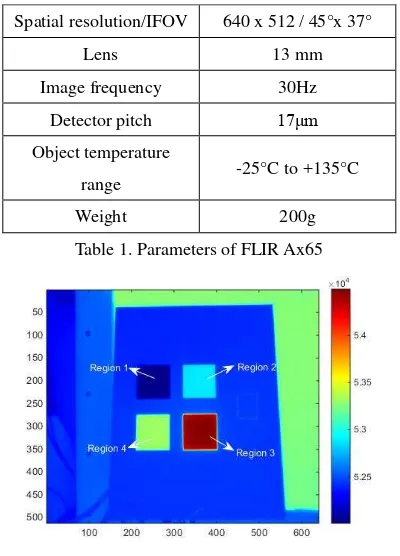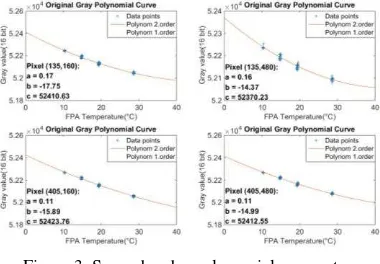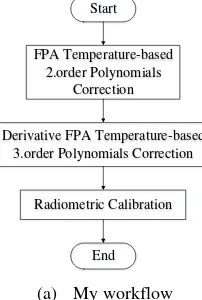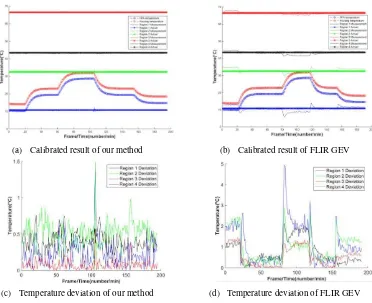SHUTTER-LESS TEMPERATURE-DEPENDENT CORRECTION FOR
UNCOOLED THERMAL CAMERA UNDER FAST CHANGING FPA
TEMPERATURE
Dong Lin a,*, Patrick Westfeld a, Hans-Gerd Maasa
a Technische Universität Dresden, Institute of Photogrammetry and Remote Sensing, 01062 Dresden, Germany -
(dong.lin, patrick.westfeld, hans-gerd.maas)@tu-dresden.de
KEY WORDS: Uncooled Thermal Camera, Fast Changing FPA Temperature, Shutter-less, Temperature-dependent
Correction, Radiometric Calibration, FLIR GEV
ABSTRACT:
Conventional temperature-dependent correction methods for uncooled cameras are not so valid for images under the
condition of fast changing FPA temperature as usual, therefore, a shutter-less temperature-dependent correction
method is proposed here to compensate for these errors and stabilize the camera’s response only related to the object
surface temperature. Firstly, sequential images are divided into the following three categories according to the
changing speed of FPA temperature: stable (0°C/min), relatively stable (<0.5°C/min), unstable (>0.5°C/min). Then
all of the images are projected into the same level using a second order polynomial relation between FPA
temperatures and gray values from stable images. Next, a third order polynomial relation between temporal
differences of FPA temperatures and the above corrected images is implemented to eliminate the deviation caused
by fast changing FPA temperature. Finally, radiometric calibration is applied to convert image gray values into object
temperature values. Experiment results show that our method is more effective for fast changing FPA temperature
data than FLIR GEV.
1. INTRODUCTION
Thanks to the fast development of microbolometer
focal plane array (FPA), thermography using uncooled
thermal cameras has achieved more and more attention
in recent years (Niklaus et al. 2007). Without the
requirement for stabilized temperature sensor, higher
spatial resolution, smaller detector pitch as well as
lower power consumption could be designed. This
makes thermal imagery more cost-effective, lighter and
smaller (Bhan et al. 2009). Therefore, uncooled
cameras are widely used in forest fire protection
(Ambrosia et al. 2003), building thermal leakage
detection (Hoegner et al. 2016,Westfeld et al. 2015),
* Corresponding author
night vision (Liu et al. 2012), face recognition
(Socolinsky et al. 2003), CO2 gas leakage from vegetation imagery (Johnson et al. 2012), water
contamination monitoring (Lega et al. 2010).
In order to make any of the above applications viable,
radiometric calibration which refers to forming a
quantitative relation between image gray values and
temperature or radiance of object has to be done
accurately. However, the biggest drawback for
uncooled thermal camera is that the camera output
depends not only on the object radiance but also on the
calibration parameters need to be updated almost
continuously. Therefore, removing the image response
from FPA temperature is important to measure the
object temperature accurately.
One FPA temperature-dependent correction method is
using one or more blackbodies to perform an online
recalibration during measurement (Kruse et al. 2001).
Although this approach holds for most of the satellite
applications for example cloud imagery system
(Thurairajah et al. 2005), it is not resource-efficient and
practicable for terrestrial applications because there is
no room for a large, heavy and expensive blackbody. In
place of blackbody, shutter is widely used as an
equivalent uniform temperature source to complete the
radiometric calibration (Nugent et al. 2014). However,
shutter-based compensation approaches have to close
the shutter regularly during the measurement which
leads to interruption and decrease of maximum
acquisition rate, so they are not fit for seamless and
real-time applications.
An alternative method is to combine FPA temperature
with the updating of correction parameters (Budzier et
al. 2015). There are several temperature-dependent
correction methods available, such as Kalman filter
(Torres et al. 2003), piecewise Lagrange interpolation
(Liang et al. 2017) and multivariate regression model
using multiple temperature inside the camera
(Tempelhahn et al. 2016). The main drawback is that
none of them take fast changing FPA temperature into
consideration in their experiments. Fast changing FPA
temperature is primarily influenced by ambient
temperature as well as self-heating when used outdoors
with wind or abrupt weather changes. Then, the
original relation (known from laboratory calibration)
between the FPA temperatures and the image gray
values is not valid anymore, which would lead to wrong
measurement without proper correction.
This paper proposes a novel shutter-less FPA
temperature-dependent real-time correction method
which is effective for fast changing FPA temperature
data. The main idea of the method presented here is,
firstly, all of the temperature-dependent models
including stable temperature-dependent model, fast
changing temperature-dependent model as well as
radiometric calibration model are established by
data-driven estimation for only one time off-the-line.
Subsequently, on-the-line, all the acquired images are
directly applied in object temperature retrieval by using
the stored calibrated parameters as well as the
temperature-dependent models.
2. PRINCIPLE OF PROPOSED METHOD 2.1 Temperature-dependent Model Determination
During the experiment, our thermal camera (FLIR
Ax65, whose parameters are shown in Table 1) is put
inside a chamber with ambient temperature changing
from 10°C to 35°C and then back, viewing a four
element Peltier blackbody (shown in Figure 1) which
are set to 11.6°C, 26.4°C, 67.6°C and 36.8°C constantly.
The maximum changing speed of FPA temperature is
more than 1°C/min, which is much more than the
condition of other papers (0.5°C/min in Nugent et al.
2013 and Nugent et al. 2014), but will probably happen
when used outdoors.
Spatial resolution/IFOV 640 x 512 / 45°x 37°
Lens 13 mm
Table 1. Parameters of FLIR Ax65
Figure 1. Four element Peltier blackbody
(1, 2, 3, 4). Then the changes of FPA temperature,
housing temperature and four pixels’ gray values via
time are shown in Figure 2.
Figure 2. FPA temperature, housing temperature and
four pixels’ gray values via time
In a next step, every image is classified to one of the
following categories, according to absolute changes of
FPA temperature over time: stable (0°C/min), relatively
stable (<0.5°C/min), unstable (>0.5°C/min). The
relation between the FPA temperatures and the gray
values from stable images is established by applying a
second-order polynomial (shown in Figure 3):
Figure 3. Second-order polynomial parameters
determination
We take one of the stable FPA temperature as reference,
all of the sequential images are projected into this
reference level using Eq. (1):
�= a(�� − �0) + �(�� − �0) + 0 (1)
where �= original digital output of the camera
�0= current FPA temperature
�� = reference FPA temperature
�= corrected digital response
a, b = second order polynomial parameters
After this correction, in terms of the stable and
relatively stable images, they are corrected into the
same gray level in general. But there are still large
deviation for unstable images. However, we found that
there is rough third order polynomial relation between
temporal difference of FPA temperature and above
corrected images. Therefore, the parameters of
third-order polynomial can be determined as shown in Figure
4.
Figure 4. Third-order polynomial parameters
determination
All of the above corrected images are modified again
using Eq. (2), (3):
= �− m ∙ ∆�� + � ∙ ∆�� + � ∙ ∆�� (2)
{
∆�� � = �� � + − �� � � � ==
∆�� � = (�� � + − �� � ) � � > && � < �⁄
∆�� � = �� � − �� � − � � == �
(3)
where �= result of previous correction
m, n, p = third order polynomial parameters
∆�� = temporal difference of FPA temperature
i = index of image sequence
= the final correction result
After this third order polynomial correction, the range
of the image gray fluctuation is much smaller, then all
radiance related.
In addition, all of these polynomial parameters above
including second order (three parameters) and third
order (four parameters) are pixel-related and
time-invariant, which actually represent matrices whose
dimensions match the pixel count of the image. All of
the FPA temperature-dependent correction above uses
only the digital output and the FPA temperature under
the condition of constant blackbody temperature
without the requirement of specific blackbody
temperature.
Finally, radiometric calibration is implemented to
convert image gray values into object temperature
values. Radiometric calibration regression coefficients
of the camera: R, B, F, O are determined with a Planck
curve Eq. (4) using at least four known object
temperature under reference FPA temperature.
� = R
��−
+ � (4)
Therefore, the inverse function Eq. (5) serves to
convert image gray values into object temperature � :
� = B
ln � − � +� (5)
2.2 Application of the Method
The workflow to use the proposed method is shown in
Figure 5(a). Firstly, the sequential images and FPA
temperatures are saved at the same time. Next, the FPA
temperature-based second-order polynomial model is
used to project all of the sequential images into the
reference level under the reference FPA temperature.
Then, all of the above corrected images are modified
again to remove the influence caused by fast changing
FPA temperature using derivative PFA
temperature-based third-order polynomial correction. Finally, the
normally stabilized response is radiometric calibrated
by applying Planck model to get the final object surface
temperature.
At the same time, we compare our results with the
results provided by FLIR GEV whose workflow is
shown in Figure 5(b). Compared with our method,
FLIR GEV applies shutter-based
temperature-dependent method to remove the response from FPA
Figure 5. Workflow of two methods
The time-related calibrated result and deviation
between the calculated temperature and actual
blackbody temperature are presented in Figure 6, which
shows that our method is much better than FLIR GEV.
Our method has a low absolute mean error (0.23°C,
0.51°C, 0.08°C, 0.40°C) and a low absolute maximum
error (1.45°C, 1.50°C, 0.57°C, 0.77°C) for all of the
regions.. On the other side, the FLIR GEV has a larger
absolute mean error (1.17°C, 0.92°C, 0.56°C, 0.74°C)
and also a bigger absolute maximum error (4.81°C,
2.64°C, 1.49°C, 2.02°C). Note that the final
uncertainty for the blackbody.
(a) Calibrated result of our method (b) Calibrated result of FLIR GEV
(c) Temperature deviation of our method (d) Temperature deviation of FLIR GEV
Figure 6. Four element blackbody experimental results provided by our method and FLIR GEV
Another experiment is implemented to testify my
proposed method. During the experiment, compared
with four element Peltier blackbody, a larger water bath
blackbody with only one constant temperature is used
to testify the effectiveness of our method. All of the
parameters (including second-order polynomial,
third-order polynomial and radiometric calibration R, B, F,
O) applied here come from the calculation of four
element blackbody experiment. Time-related
calibrated result is presented in Figure 7, which proves
the effectiveness and stability of our method. Note that
the maximum changing speed of FPA temperature is
almost the same in these two experiments.
(a) Calibrated result of our method (b) Temperature deviation of our method
Figure 7. Water bath blackbody experimental results provided by our method
3. CONCLUSION
Traditional shutter-based techniques such as software
FLIR GEV always assumes that FPA temperature
accurately describes the shutter temperature, however,
this assumption is not valid any more when FPA
camera is used in the terrestrial application, such as
building thermal leakage detection, water
contamination monitoring, we care more about
temperature difference which represents thermal
leakage or sewage source rather than accurate
temperature. Therefore, the large deviation range
provided by FLIR GEV would probably lead to faulty
judgment. On the other side, our method is more
efficient for fast changing FPA temperature data.
Furthermore, our method could still be improved in the
future by analyzing the relatively large error existed at
some of the beginning stages when fast changing FPA
temperatures happen. In addition, whether this method
is stable or not still needs more cameras to testify.
ACKNOWLEDGEMENTS
The research work in this paper has been funded by Chinese Scholarship Council and …. In addition, authors would like to acknowledge Dipl. Sandmann, Dr.
Budzier and Professor Gerlach (from Solid-State
Electronics Laboratory, Dresden) for providing
blackbody, chamber and great support.
REFERENCE
Ambrosia V G, Wegener S S, Sullivan D V, et al.
Demonstrating UAV-acquired real-time thermal data
over fires [J]. Photogrammetric engineering & remote
sensing, 2003, 69(4): 391-402.
Bhan R K, Saxena R S, Jalwani C R, et al. Uncooled
infrared microbolometer arrays and their
characterisation techniques[J]. Defence Science
Journal, 2009, 59(6): 580.
Budzier H, Gerlach G. Calibration of uncooled thermal
infrared cameras [J]. Journal of Sensors and Sensor
Systems, 2015, 4(1): 187-197.
Hoegner L, Tuttas S, Stilla U. 3D building
reconstruction and construction site monitoring from
RGB and TIR image sets[C]//Electronics and
Telecommunications (ISETC), 2016 12th IEEE
International Symposium on. IEEE, 2016: 305-308.
Johnson J E, Shaw J A, Lawrence R, et al. Long-wave
infrared imaging of vegetation for detecting leaking
CO2 gas [J]. Journal of Applied Remote Sensing, 2012,
6(1): 063612-063612.
Kruse P W. Uncooled thermal imaging: arrays, systems,
and applications [M]. SPIE press, 2001.
Lega M, Napoli R M A. Aerial infrared thermography
in the surface waters contamination monitoring [J].
Desalination and water treatment, 2010, 23(1-3):
141-151.
Liang K, Yang C, Peng L, et al. Nonuniformity
correction based on focal plane array temperature in
uncooled long-wave infrared cameras without a shutter
[J]. Applied Optics, 2017, 56(4): 884-889.
Liu Z, Blasch E, Xue Z, et al. Objective assessment of
multiresolution image fusion algorithms for context
enhancement in night vision: a comparative study [J].
IEEE transactions on pattern analysis and machine
intelligence, 2012, 34(1): 94-109.
Niklaus F, Vieider C, Jakobsen H. MEMS-based
uncooled infrared bolometer arrays: a
review[C]//Photonics Asia 2007. International Society
for Optics and Photonics, 2007: 68360D-68360D-15.
Nugent P W, Shaw J A, Pust N J. Correcting for
focal-plane-array temperature dependence in
microbolometer infrared cameras lacking thermal
stabilization[J]. Optical Engineering, 2013, 52(6):
061304-061304.
Nugent P W, Shaw J A, Pust N J. Radiometric
calibration of infrared imagers using an internal shutter
as an equivalent external blackbody [J]. Optical
Engineering, 2014, 53(12): 123106-123106.
Socolinsky D A, Selinger A, Neuheisel J D. Face
recognition with visible and thermal infrared imagery
[J]. Computer vision and image understanding, 2003,
Tempelhahn A, Budzier H, Krause V, et al. Shutter-less
calibration of uncooled infrared cameras [J]. Journal of
Sensors and Sensor Systems, 2016, 5(1): 9.
Torres S N, Pezoa J E, Hayat M M. Scene-based
nonuniformity correction for focal plane arrays by the
method of the inverse covariance form [J]. Applied
optics, 2003, 42(29): 5872-5881.
Thurairajah B, Shaw J A. Cloud statistics measured
with the infrared cloud imager (ICI) [J]. IEEE
Transactions on Geoscience and Remote Sensing, 2005,
43(9): 2000-2007.
Westfeld P, Mader D, Maas H G. Generation of
tir-attributed 3d point clouds from uav-based thermal
imagery [J].



